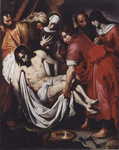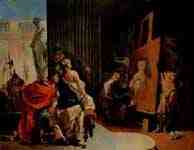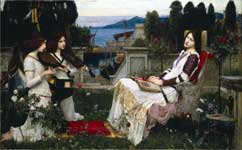Montreal Museum of Fine Arts (MMFA) (French: Musée des beaux-arts de Montréal)

The Deposition, Pieter van Mol

Alexander the Great and Campaspe in Apelles Studio, Giovanni Battista Tiepolo

Saint Cecilia, John William Waterhouse
The Montreal Museum of Fine Arts (MMFA) (French: Musée des beaux-arts de Montréal) is an art museum in Montreal, Quebec, Canada. It is Montreal's largest museum and is amongst the most prominent in Canada. The museum is located on the historic Golden Square Mile stretch of Sherbrooke Street.
The MMFA is spread across four pavilions, and occupies a total surface area of 45,067 square metres (485,100 sq ft), including 13,000 square metres (140,000 sq ft) of exhibition space. A fifth pavilion is currently under construction, which will have a surface area of 3,460 square metres (37,200 sq ft). This expansion will make it the eighteenth largest art museum in North America.[2] The permanent collection includes approximately 40,000 works.[2] The original 'reading room' of the Art Association of Montreal was the precursor of the current library of the museum. It is the oldest library in Canada dedicated to art.[3]
The Montreal Museum of Fine Arts is a member of the International Group of Organizers of Large-scale Exhibitions,[4] also known as the Bizot Group, a forum which allows the leaders of the largest museums in the world to exchange works and exhibitions. The Museum is affiliated with: CMA, CHIN, and Virtual Museum of Canada.
History
Beginnings
Founded in 1860 by Bishop Fulford, the Art Association of Montreal was created to encourage the appreciation of fine arts among the people of the city.[5]
Since it did not have a permanent place to store acquisitions the Art Association was not able to acquire works to display nor to seek works from collectors. During the following twenty years, the organization had an itinerant existence during which its shows and expositions were held in various Montreal venues.[6]
In 1877, the Art Association received an exceptional gift from Benaiah Gibb,[7] a Montreal businessman. He gave the core of his art collection consisting of 72 canvases and 4 bronzes. In addition he donated to the Montreal institution a building site on the north-east corner of Phillips Square and further the sum of money of $8,000. This latter gift was on condition that a new museum be constructed on the site within three years.[8] On the 26 May 1879, the Governor General of Canada, Sir John Douglas Sutherland Campbell, inaugurated the Art Gallery of the Art Association of Montreal, the first building in the history of Canada to be constructed specifically for the purpose of housing an art collection.[9] The Art Gallery at Phillips Square comprised an exhibition room, another smaller room (known as the Reading Room)[3] reserved for graphic works as well as a lecture hall and an embryonic art school. The museum was enlarged in 1893. The Art Association held an annual show of works created by its members as well as a Spring Salon devoted to the works of living Canadian Artists.
The gift made by Benaiah Gibb was a watershed event in the founding of the museum's collection. The generous gift engaged a keen interest in the public and, because of it, the donations multiplied.
Move to Sherbrooke Street West
The New Art Gallery (today the Michal and Renata Hornstein Pavilion) seen on Sherbrooke Street West in 1913.
Too cramped at its original location, the Art Association strongly considered the idea of moving from Phillips Square to the Golden Square Mile, where the most of the city's financial elite lived at the time. They settled on the site of the abandoned Holton House, on Sherbrooke Street West, for the construction of the new museum. Senator Robert Mackay, the owner of the property, was convinced to sell the house for a good price.[10] A committee responsible for the construction of the museum was formed consisting of James Ross, Richard B. Angus, Vincent Meredith, Louis-Joseph Forget and David Morrice (the father of painter James Wilson Morrice).[10] Most members of this committee offered a considerable amount of their own money for the construction of the museum. This included a large donation by businessman James Ross.[11]
A limited architectural design competition was conducted to select an architect among three architectural firms that were invited to apply. The Museum Committee selected the project proposed by brothers Edward Maxwell and William Sutherland Maxwell. Trained in the Beaux-Arts tradition, they proposed a building that catered to French taste of the time: sober and majestic.[12] Work began in the summer of 1910 and finished in the fall of 1912.
On December 9, 1912, the Governor General of Canada, Prince Arthur, Duke of Connaught and Strathearn, inaugurated the new Museum of the Art Association of Montreal on Sherbrooke Street West in front of 3,000 people present for the occasion.
Modern era
In 1949, the Art Association of Montreal was renamed as the Montreal Museum of Fine Arts, which was more representative of the institution's mandate.[13]
In 1972, the MMFA became a semi-public institution funded mainly by government funds.[14]
An expansion of the museum was undertaken during the 1970s culminating in 1976, with the opening of the Liliane and David M. Stewart Pavilion. Designed by architect Fred Lebensold the building backs directly onto the back of the Michal and Renata Hornstein Pavilion. The building's architecture is modernist, made of concrete structures located along du Musée Avenue and in contrast with the classical architecture of the first pavilion. It was controversial at the time, despite innovations like the ceiling box for a track lighting and large open interior. The pavilion houses nearly 900 decorative art and design objects. Most objects come from were donated by Liliane and David M. Stewart, hence the name of the pavilion. The collection includes furniture, glass, silverware, textiles, ceramics and works of industrial design. These objects were made of a variety materials, reflecting their origins in different countries and time periods.[15]
The appointment of Bernard Lamarre in 1982 as president of the board of directors, revitalized the Museum after several difficult years.[16] In the mid 1980s, he proposed a major expansion of the museum. This proposal led to the construction of the Jean-Noël Desmarais Pavilion.[17] In 1991, the museum's third building, designed by Moshe Safdie, was built on the south side of Sherbrooke Street. It was funded by contributions from governments and the members of the business community, notably the Desmarais family. Safdie's architectural design incorporated the facade of New Sherbrooke Apartments, an apartment-hotel that occupied the site since 1905.[18]
1972 robbery
On September 4, 1972, the museum was the site of the largest art theft in Canadian history, when armed thieves made off with jewellery, figurines and 18 paintings worth a total of $2 million at the time (approximately $11.2 million today), including works by Delacroix, Gainsborough and a rare Rembrandt landscape ("Landscape with Cottages"). The works have never been recovered. In 2003, the Globe and Mail estimated that the Rembrandt alone would be worth $1 million.[19]
Pavilions
Michal and Renata Hornstein Pavilion
Claire and Marc Bourgie Pavilion, Montreal Museum of Fine Arts, formerly the Erskine and American United Church
Atrium of the Jean-Noël Desmarais Pavilion, Montreal Museum of Fine Arts
The museum is partitioned into three pavilions: a 1912 Beaux Arts building designed by William Sutherland Maxwell and brother Edward Maxwell,[20] now named the Michal and Renata Hornstein Pavilion; the modernist Jean-Noël Desmarais Pavilion across the street, designed by Moshe Safdie, built in 1991; and the Liliane and David M. Stewart Pavilion.
While the Desmarais Pavilion houses works of art from around the world, the Hornstein's focus is specifically Quebec history. Together, the edifices house about 30,000 pieces.
On February 14, 2007, the museum's administration board announced its project to convert Erskine and American United Church, located on Sherbrooke West street, into a Canadian art pavilion. This new pavilion allowed the museum to double the display surface currently dedicated to Canadian artists. Erskine and American United Church, a Romanesque Revival church with Tiffany stained glass, dating from 1893–94, was designated a National Historic Site of Canada in 1998.[21][22] Named the Claire and Marc Bourgie pavilion, as a recognition of the family's outstanding financial support it opened in 2010.
With the addition of a fifth pavilion, the Montreal Museum of Fine Arts will occupy a surface area of 48,527 square metres (522,340 sq ft), of which 13,000 square metres (140,000 sq ft) is dedicated to exhibition space. The expansion will make it the eighteenth largest art museum in North America.[2]
Pavilion Surface area
Michal and Renata Hornstein Pavilion (1912) 5,546 m2 (59,700 sq ft)
Liliane and David M. Stewart Pavilion (1976) 9,610 m2 (103,400 sq ft)
Jean-Noël Desmarais Pavilion (1991) 22,419 m2 (241,320 sq ft)
Claire and Marc Bourgie Pavilion (2011) 5,460 m2 (58,800 sq ft)
Fifth Pavilion (2017) 3,460 m2 (37,200 sq ft)
Sculpture Garden 2,033 m2 (21,880 sq ft)
Collection
In 1892, John W. Tempest bequeathed sixty oil paintings and watercolor paintings as well as a trust fund for the purchase of works of art. This was the main source of income for the Museum's acquisition of European paintings until the 1950s.[23]
In the late nineteenth and early twentieth century, the large art collections owned by many prominent Montreal families became dispersed through shared inheritance. However, some heirs made large donations to the Museum, such members of the Drummond, Angus, Van Horne, and Hosmer families, among others.[23] In 1927, a collection of over 300 objects, including 150 paintings, was donated by the descendants of Baron Strathcona and Mount Royal.[23]
In 1917, the Art Association of Montreal created a department devoted to the decorative arts. The department was entrusted to Frederick Cleveland Morgan, who became the curator of the collection on a voluntary basis from 1917 until his death in 1962. Morgan added more than seven thousand pieces in the form of acquisitions, bequests or donations to the Museum's collection.[24] He also expanded the mandate of the museum, from an institution dedicated solely to the fine arts to an encyclopedic museum, open to all forms of art.[25]
Since 1955, the museum gained the acquisition funds it needs to buy Canadian or foreign works from the legacy of Horsley and Annie Townsend. Several gifts and bequests are made by the heirs or descendants of the great collectors who founded the Art Association. Other donations come from new donors such as Joseph Arthur Simard, who in 1959 offered a collection of 3,000 Japanese incense boxes that belonged to the French statesman Georges Clemenceau.[26]
In 1960, the centennial of the founding of the Art Association of Montreal was highlighted by the publication of a catalog of selected works from the collection and a museum guide.
On September 4, 1972, a major theft took place at the Museum. Fifty objects were taken including eighteen paintings, including works by Peter Paul Rubens, Rembrandt, Jean-Baptiste-Camille Corot and Eugène Delacroix that were never recovered.[26]
Major contributions have been made by Renata and Michal Hornstein since the 1970s. These have included works by Old Masters, as well as several of the largest collections of drawings of the Swiss painter Ferdinand Hodler.[27]
These gifts expanded the range of the Museum's collections, and reached a peak in 2000, with admission of the modern design collection assembled by Liliane M. Stewart and David M. Stewart, long a part of the Montreal Decorative Arts Museum and exhibited at the MMFA from 1997 to 2000.[27][28] Liliane M. Stewart donated over 5,000 objects to the Museum's collection (estimated value of C$15 million). This donation is still one of the largest donations made to a museum Canadian history.
See also
Canadian art
List of Museums in Canada
List of most visited art museums in the world
List of museums
References
"Bilan 2011". Tourisme Montréal. Retrieved 24 May 2013.
"2012-13 Annual Report". Montreal Museum of Fine Arts.
MMFA Library
Bizot Policy Statement
Georges-Hébert Germain, Un musée dans ma ville. Une histoire du musée des beaux-arts de Montréal, 2007, @p.15.
Georges-Hébert Germain, Un musée dans ma ville. Une histoire du musée des beaux-arts de Montréal, 2007, @p.25.
fr:Benaiah Gibb
Georges-Hébert Germain, Un musée dans ma ville. Une histoire du musée des beaux-arts de Montréal, 2007, @p.30.
Georges-Hébert Germain, Un musée dans ma ville. Une histoire du musée des beaux-arts de Montréal, 2007, @p.26.
Germain, Georges-Hébert (2007). Un musée dans ma ville. Une histoire du musée des beaux-arts de Montréal (in French). p. 54.
Michel Champagne. "The Canadian Encyclopedia". The Canadian Encyclopedia. Retrieved 2012-07-26.
Germain, Georges-Hébert (2007). Un musée dans ma ville. Une histoire du musée des beaux-arts de Montréal (in French). p. 55.
Germain, Georges-Hébert (2007). Un musée dans ma ville. Une histoire du musée des beaux-arts de Montréal (in French). p. 97.
see Mission and History tab
Pepall, Rosalind (2012). "Le design au fil des siècles : actuel, intemporel, surprenant". Revue M du musée des beaux-arts de Montréal (in French) (Spring): 12. ISSN 1715-4820.
Germain, Georges-Hébert (2007). Un musée dans ma ville. Une histoire du musée des beaux-arts de Montréal (in French). p. 198.
"Bernard Lamarre GOQ". National Order of Quebec. Government of Quebec.
"Rue Sherbrooke Ouest (entre Atwater et Peel)". Base de donnés sur le patrimoine. Grand répertoire du patrimoine bâti de Montréal. Retrieved 22 January 2014.
"CBC Digital Archives, ''Art heist at the Montreal Museum of Fine Arts''". Archives.cbc.ca. Retrieved 2012-07-26.
"Five Best". Montreal Gazette. December 7, 1985. p. 22. Retrieved December 26, 2009.
"Erskine and American United Church". Directory of Designations of National Historic Significance of Canada. Parks Canada. Retrieved July 30, 2011.
Erskine and American United Church. Canadian Register of Historic Places. Retrieved July 30, 2011.
Guide des collections du musée des beaux-arts de Montréal, 2003, p. 19.
Guide des collections du musée des beaux-arts de Montréal, 2003, p. 21.
Bondil, Nathalie (2012). "Le design moderne selon Liliane M. Stewart : une collection d'exception, une entreprise de l'esprit". Revue M (in French) (Montreal Museum of Fine Arts) (Spring 2012): 14. ISSN 1715-4820.
"Musée des beaux-arts de Montréal - De l’Art Association of Montreal au musée des beaux-arts de Montréal" (in French). Montreal Museum of Fine Arts. Archived from the original on 2011-12-21.
Guide des collections du musée des beaux-arts de Montréal, 2003, p. 22.
"Collection - Decorative Arts and Design". Montreal Museum of Fine Arts. Retrieved 28 January 2014.
----
Fine Art Prints | Greeting Cards | Phone Cases | Lifestyle | Face Masks | Men's , Women' Apparel | Home Decor | jigsaw puzzles | Notebooks | Tapestries | ...
----
Artist
A - B - C - D - E - F - G - H - I - J - K - L - M -
N - O - P - Q - R - S - T - U - V - W - X - Y - Z
Retrieved from "http://en.wikipedia.org/"
All text is available under the terms of the GNU Free Documentation License


